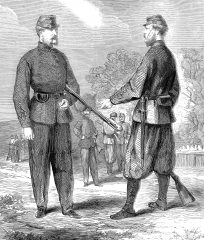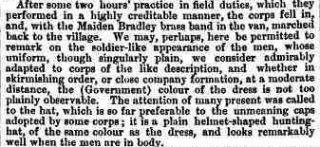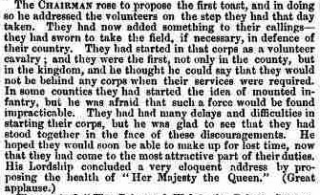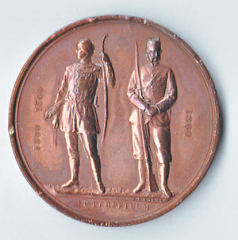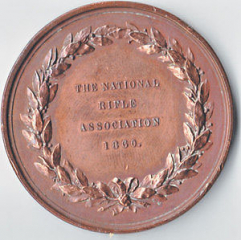When I began my family history research, one of the few clues to my Jefferys ancestry was then wrapped in newspaper, in a box, in the far distance depths of the cupboard under the stairs.
I had to remove everything else from the cupboard to reach it but I finally retrieved the box and placed it on the table. I carefully removed the contents: a silver tea service consisting of a teapot, milk jug and sugar bowl. After cleaning, it looked like this:
The inscriptions read:
“Won by Corpl T K Jefferys 6th Wilts”
“WRA 1870 Warminster Plate”
“Wiltshire Rifle Association 1870 Presented by the Town of Warminster”
I knew from my grandfather’s birth certificate that TK Jefferys was Thomas King Jefferys, my great grandfather, and that he was a farmer.
In December 2013, several years after I started researching the family history, I began wondering: Why was a farmer apparently also a member of what sounded like an army corps? Who were the 6th Wilts? What was the Wiltshire Rifle Association?
Volunteer Rifle Corps
By the early 1800s, as well as the regular army and navy, Britain had two volunteer forces: the Militia and the Yeomanry.
The Militia
Originally a conscripted force, the Militia had become a volunteer infantry force, primarily consisting of men such as agricultural labourers and colliers and others who, in return for pay and a financial retainer, could leave their work, undertake several months of training, return to their normal lives and work but attend regular training camps. The volunteer regiments could be sent to work alongside the regular army overseas.
The Yeomanry
The yeomanry were a voluntary cavalry force, with officers often drawn from the nobility and landed gentry and the men from their tenant farmers or local yeoman who owned their own farms. They could not be obliged to serve overseas without their individual consent.
The Yeomanry Regiments were used extensively in support of the civil authorities to quell riots and civil disturbances. As police forces were formed, so the Yeomanry concentrated on local defence.
In the mid nineteenth century, not only was the British Empire expanding, with the consequential need for the army to provide garrisoned troops in distant countries, but so was the risk of being drawn into other countries’ armed conflicts or war.
During the Crimea War (October 1853 – February 1856) the War Office had been forced to send both militia and yeomanry to augment the forces and the British Government realised that it had insufficient forces to garrison the Empire, send forces to new areas of conflict as they arose and to defend the country at home. Although Napoleon Bonaparte had finally been defeated in the Battle of Waterloo in 1815, France remained an ever present threat to Britain.
On 29 April 1859, war broke out between France and the Austrian Empire and there were fears that Britain might be caught up in a wider European conflict, again requiring the sending of the Militia and Yeomanry Forces overseas and, without the necessary troops at home to defend the country, it would be at great risk from Bonaparte’s covetous intentions and from the French army, which was much larger than Britain’s.
And so, on 12 May 1859, the Secretary of State for War issued a circular letter to lieutenants of counties in England, Wales and Scotland, authorising the formation of volunteer rifle corps and of artillery corps in defended coastal towns.
The country responded with patriotic fervour. Alfred, Lord Tennyson, who was the poet laureate at the time, had, in 1854, written “The Charge of the Light Brigade” about the Battle of Balaclava during the Crimean War. Now he wrote “The War”, also known as “Riflemen Form”, in which he exhorted men to “be not gull’d [deceived] by a despot’s plea!”, to forget their current concerns, which weren’t important if the fleet [navy] was ruined and cities were in flames.
Form, be ready to do or die!
Form in freedom’s name and the Queen’s!
True, that we have a faithful ally,
But only the devil knows what he means!
Form! Form! Riflemen form!
Ready, be ready to meet the storm!
Riflemen, riflemen, riflemen form!”
There had already been a temporary defence force during the Napoleonic Wars but the new corps were to be permanent. The force could be called out “in case of actual invasion, or of appearance of an enemy in force on the coast, or in case of rebellion arising in either of these emergencies”.
Rifle corps were to harass the invading enemy’s flanks, while artillery corps were to man coastal guns and forts. Engineer corps were also formed, principally to place underwater mines for port defence and, in a handful of counties, units of light horse or mounted rifles were formed.
Members were to provide their own arms, equipment and uniforms, at their own cost, except when assembled for actual service, when they would receive regular army pay. Although volunteers were to pay for their own firearms, they were to be provided by the War Office, so as to ensure uniformity of gauge. To be considered as “effective” members must attend eight days drill and exercise in four months, or twenty-four days within a year.
All over the country, men responded to the call to train to protect their country, their womenfolk, their children and their homes.
And, from 1860, so did school-age boys (usually at private schools) who formed the forerunners of the Army Cadet Force. They paid for, and trained with, arms supplied by the War Office.
So, the Volunteer Force was a citizen army of part-time rifle, artillery and engineer corps, created as a popular movement in 1859 to deal with the threat of invasion from France.
Over the years, the units of volunteers became increasingly integrated with the British Army and, in 1908, they formed part of the new Territorial Force. Most of the regiments of the Territorial Army Infantry, Artillery, Engineers and Signals units are directly descended from Volunteer Force units.
Now known as the Army Reserve, units and individuals provide routine support to the regular army overseas and may be deployed on six month-long tours of duty.
Jan 21, 1860
THE ILLUSTRATED LONDON NEWS
Uniform for Volunteer Rifle Corps
recommended for general adoption
by the War-Office Committee
Maiden Bradley Volunteer Rifle Corps
In December 1859, the Devizes and Wiltshire Gazette reported on the Volunteer Rifle Corps which were being formed around the major towns as a result of the War Office Circular of 12 July 1859.
The Maiden Bradley Corps was different to the others as it was composed of cavalry as well as infantry and was known as the Maiden Bradley Irregulars, the 6th Wilts Rifle Corps.
The Corps was made up by tenants of the Duke of Somerset (whose seat was at Maiden Bradley) and commanded by the Earl of St Mawr, Lord Seymour. Drilling was combined with hunting as most of the members lived on farms in the Blackmore Vale country, while at Warminster were the kennels of the South Wilts Hunt of whom their Lieutenant Colonel was the Master.
The model was described in February 1860 by Lord Seymour (who was at the Relief of Lucknow during the Indian Mutiny). The horsemen were to be based on the irregular cavalry of India but armed with a rifle effective at long range. They would need to dismount in order to use the rifle but whilst in the saddle their weapon would be the sword.
“They are never to fire from horseback, but if attacked by an enemy whilst skirmishing on foot they will retire to their horses, remount, and hold themselves in readiness to show that dashing gallantry for which the English Irregular Horse must henceforth be remarkable.”
The Salisbury and Winchester Journal and General Advertiser, 12 May 1860 reported on the swearing-in of the Maiden Bradley Irregulars.
Witnessing the day’s events and present at the following dinner were Miss Jefferys, Mr E. Jefferys and Mrs Jefferys [the parents and sisters of Stiles (Styles) Edward Jefferys, of Rye Hill Farm. Hill Deverill], and Mr W Jefferys [his uncle William Jefferys of Church Farm].
After the dinner, there followed a great many speeches, toasts and much cheering, after which Mr Harding sang “Red, White and Blue” and Mr W Jefferys “gave the song of “Carrotty Poll” which elicited hearty applause.”
The corporal was twenty four year old Stiles Edward Jefferys, later Colour Sergeant and commissioned Ensign Jefferys in 1867. He was joined in the 6th by his brother, Stephen Robert who was five years younger.
On the day in May 1860 that the Maiden Bradley Irregulars, with Stiles Edward Jefferys and his brother Stephen Robert in their midst, marched to their swearing-in as members of the Volunteer Rifle corps, one of the households in Maiden Bradley was that of Robert Jefferys of Perry Farm. His son Thomas King Jefferys was then aged eleven.
No doubt young Thomas, cousin of Stiles Edward and Stephen Robert, was there at the swearing-in event, watching the spectacle with wonder, listening to the patriotic music played by the band, perhaps marching or running alongside the volunteers. Did he wonder if he too, would get to wear the uniform, march in parades and learn how to protect his family from the French?
In due course he was to follow his cousins into the Wilts 6th Rifle Corps.
By 1880 there were eighteen volunteer rifle corps located around the major towns of the county and they were combined to form two Wiltshire Rifle Volunteer battalions but by then the old 6th (Irregular Cavalry) Corps from Maiden Bradley had been disbanded.
The Shooting Matches of the Wiltshire Rifle Association
The following extracts and information have been gathered from the British Newspapers Archives 1810 – 1953.
The spelling of Jeffreys, Jefferies and Jefferys was variable, even when referring to the same person in the same article. I have transcribed the spellings as they were reported.
The Association began in 1860, with the object of encouraging the progress of the Volunteer movement by creating and fostering a taste for rifle shooting throughout the county.
There was to be an Annual General Meeting (generally held in April or May) and an Annual Shooting Match (initially in September but then in late July or August). Being a farming county, the annual shooting match had to avoid the growing crops and harvest time. Both meetings were to be held alternately in the north and south of the county, at Devizes or Salisbury.
Membership was by subscription, with the Committee having fixed the terms “at so low a rate in order to render the Society as general as possible; but they trust that those gentleman who may be in a position to do so, will contribute in such a manner as to render the Association worthy of the county”.
The shooting match was initially a two day event but grew to four days before better organisation and a greater number of ranges and targets reduced it to two days again. There were cups and monetary prizes donated by local dignitaries and supporters of the association. Competition was open to the volunteer members and, for some classes of competition, to any resident in the county willing to contend for the prizes.
The Devizes and Wiltshire Gazette reported the First Annual Shooting Match as
not only of especial interest to the people of Wiltshire, but of importance as belonging to a great national movement that has spread over the whole length and breadth of the land; – an occurrence which, we doubt not, will be memorable as the commencement of a course of defensive military training to be kept up among us for generations to come.”
Those were indeed prophetic words. Most of the regiments of the present Territorial Army Infantry, Artillery, Engineers and Signals units are directly descended from Volunteer Force units and, generations later, people still join the Territorial Army and become involved in active service in the defence of the country.
Given the vagaries of the English weather, over the eleven years which our story covers, the shooting matches took place in everything from hail, wind and rain (all in the space of a few hours) to oppressive heat. In 1863 the first three days were held in drenching rain, the fourth in bright sunshine.
No doubt the “scorching and oppressive heat” in 1869 led to increased custom at the two refreshment tents provided by the landlord of the White Hart, Devizes. The heat was in direct contrast to that experienced in 1866, when the rain poured in torrents throughout the day, wetting the competitors to the skin.
Three members of the Jefferys family in the 6th Wilts (Maiden Bradley) featured among the top scorers and prize winners, with at least one and sometimes two of them appearing at each of the annual shooting matches.
Stephen Robert Jefferys, as a Private in 1861 and 1864, was listed among the top scorers and in 1864 he was second in the Challenge Cup. By 1865 he had been promoted to Corporal.
Stiles Edward Jefferys, was first mentioned in 1862 as Sergeant. By 1864 he had been promoted to Colour Sergeant and in 1867 he received his commission as Ensign Jeffreys. Stiles’ last appearance at the annual shooting match was as Mr S E Jefferys HM [Honorary Member].
From 1866 to 1870, Stiles attended the Annual General meeting of the Association.
Thomas King Jefferys first attended the annual shooting match in 1869 as Corporal Jeffreys.
I don’t know whether any other Volunteers represented Maiden Bradley and the 6th Wilts Volunteer Rifle Corps but only the three Jefferys appear in the lists of high scorers and winners between 1861 and 1872.
The Challenge Cup
The main competition each year was for the Challenge Cup. For the cup to become the absolute property of a competitor he would have to win it for three years in succession. It was “a very fine tankard, with rich grotesque chasing; the workmanship was of the best description, and it had on the top of the cover a well-modelled figure of a Rifleman in the act of taking aim”.
Stiles Edward Jefferys made his first appearance in the list of scorers in the Challenge Cup competition in 1862, with a score of 21 against the winner’s score of 38.
In 1864, the newspaper reported that “the rain was at times so thick that the targets could scarcely be seen; whilst the wind blew almost a gale, giving to everything and everybody a most wretched appearance”.
The cup was won by twenty eight year old Colour Sergeant Stiles Edward Jefferies. Included in his overall score was 16 at 900 yards, “which was most extraordinary, considering the strong wind that was blowing“.
His brother, Private Stephen Robert Jefferies came second, winning the Major Ward’s cup.
In 1865, Colour Sergeant Jefferies’ score of 25 was beaten by Corporal Jefferies, who scored 27. I think this was Stephen Robert Jefferys having been promoted to Corporal as Thomas King Jefferys would have been just seventeen, presumably too young to be a corporal.
In 1868 Ensign Jeffreys scored 28 against the winner’s 38 and, in 1869, 31 against the winner’s 43.
The 1870 Challenge Cup was held over 300, 600 and 700 yards, five rounds at each distance.
Corporal [Thomas King] Jefferys, aged twenty-one, beat eight other entrants, with an aggregate score of 32, three more than the Lieutenant who came 2nd.
Together with the cup, Corporal Jefferys won a piece of silver plate presented by the inhabitants of Warminster, value £25, which turned out to be the silver plated tea service which we still have, over one hundred and forty years later.
For the same event, he also won a bronze medal of the NRA (National Rifle Association) and the right to compete for the prize (value £100) presented by HRH the Prince of Wales at the Wimbledon meeting of the National Rifle Association the following year.
The Annual Prize Meetings
In 1862 Stiles was listed among the top scorers and in 1863 he won second place in Class B (open to all residents in the county) 1st range, 200 and 300 yards. His prize was 5 guineas.
As Colour Sergeant in 1864, Stiles won two cups but had to give them up as the rules of the association meant that no winner could be awarded more than one first prize and he won the prestigious Challenge Cup that year.
Stiles was listed amongst the top scorers for several of the competitions in 1865.
In 1866 Colour Sergeant Jefferies won a piece of silver plate, worth 50 guineas, plus a further 2 guineas in another competition.
Achieving high scores in other competitions, he came third when the aggregate scores at all the ranges in Class A were calculated, winning an additional 2 guineas.
The newspaper reported that Mr Styles Jeffreys, Mr Robert and the Misses Jeffreys attended the ball on the Friday night. Were these Stiles Edward, his brother Stephen Robert and their sisters Lucretia and Eliza?
In 1867, at the Annual General Meeting, the adoption of the Hon Secretary’s report was seconded by Colour Sergeant Jefferies. And Mr Stiles Jefferys was to act as treasurer of a fund established to buy a fitting memento for the outgoing secretary.
A few weeks later, the Lord-Lieutenant of the County of Wilts commissioned Stiles Edward Jefferys, gentleman, as Ensign, signed on 13 June 1867.
He continued to feature amongst the high scorers over several competitions at the annual shooting match that year.
In 1868, Ensign Jeffreys came third in Class C which was open to all members of the enrolled forces of the country, with Government Rack Rifles, .577 Bore, in use in their respective corps. Five shots at each distance. His prize was £3.
He won second prize, to the value of £10 10s, in the Officers’ Prizes, competed for by the Officers of the 1st and 2nd battalions of Wilts Rifle Volunteers and was listed amongst the high scorers in other competitions.
In 1869 Ensign Jefferies was again present at the annual meeting of the Association. The question of the date of the next annual prize meeting arose. It was suggested that the 10th and 11th August would be suitable days but…
He was noted as of the 14th Wilts but it seems to have been an error as, later in the year, at the annual prize meeting, he was once more noted as of the 6th.
That year, amongst the prize winners or higher scorers were Ensign Jeffreys and Corporal Jeffreys of the 6th (Maiden Bradley) and Private Jefferies of the 5th (Devizes).
We know that the Ensign was Stiles Edward Jefferys and I think that the Corporal was Thomas King Jefferys but I don’t know who Private Jefferies was. The 5th may have been another reporting error but there was a number of Jefferies in the area, possibly descended from the brother of Robert, Stiles and Thomas’ great grandfather, who kept the spelling Jefferies when our branch of the family became Jefferys.
Class A: Open to the “efficient members” only of any Volunteer Rifle or Yeomanry Corps in the County. Position standing at 200 and 300 yards; kneeling at all other Ranges to 600, and at 700 yards any position. Five shots each distance.
Both Ensign Jefferies and Corporal Jefferies achieved scores of 65 and came joint 11th place behind a winning score of 83.
In Class C: Open to members of all the enrolled forces of the county, five shots each distance, Ensign Jefferies scored 45 against the winner’s 46. Corporal Jefferys scored 32. [Hurray, the first correct spelling of our name!]
In the Second Series (five shots at each distance: 200, 500, and 600 yards), Ensign Jefferies came second with a score of 41, just one point behind the winner. Corporal Jefferies achieved 37 and Private J. Jefferies of the 5th scored 30, winning the prize for the best score over 600 yards.
Ensign Jeffreys won the Officer Prizes competition, winning £21 in the process.
In the Challenge Cup, Ensign Jeffreys scored 31 against the winner’s 43 and Corporal Jefferies won the Consolation Prizes competition for seven shots at 400 yards.
By this time, it was evident that Corporal Thomas King Jefferys was threatening the dominance of his cousin, Ensign Stiles Edward Jefferys, at the annual shooting match of the Wiltshire Rifle Association.
They lived just three miles apart, regularly trained at the corps meetings and the families would have met quite often at family and social occasions. I wonder if there was any rivalry between the two families.
In 1870 the annual meeting of the association was held in May, at Warminster.
It was reported that the number and amount of prizes given in the previous year’s annual prize meeting was greater than in any previous year and the number of competitors the highest number that had yet attended the Association’s prize meetings. There had been 310 competitors, of which 138 were members of the Wilts Rifle Volunteers.
Even though there was an increased number of prizes and competitors, the whole event had been managed over two days.
Stiles Jefferys proposed that the retiring vice presidents be re-elected for the year. And he seconded the proposal that the annual prize meeting that year should be held at Warminster.
He was reported by the newspaper as Lieutenant Jeffreys but it seems to have been an error as, at the annual shooting match, he was again Ensign Jeffreys.
The annual shooting event that year took place at Warminster for the second time in the competitions history. On the first day, “the weather was fine, but a strong and varying wind from the left and left rear interfered very much with the scoring“.
Class A: Open to “efficient members” only of any Volunteer rifle or Yeomanry corps in the country. Position standing at 200 and 300 yards, kneeling at 400, 500 and 600 yards; and any position at 700 yards. Five shots at each distance. Corporal Jefferys scored 58 and Ensign Jeffrey scored 55, compared with the winner’s 70.
Second Series: 5 shots at each distance over 200, 500 and 600 yards. Ensign Jefferys scored 34 and Corporal Jefferys scored 32, compared with the 43 of the winner. Corporal Jefferys took fourth prize, £3, for the second best score at 200 and 500 yards.
Class C: Open to all the enrolled forces of the county, with the rack rifles used by their respective Corps. 200, 400 and 600 yards, 5 shots at each distance. Corporal Jefferys scored 36 against the winning 42. Ensign Jeffreys scored 32.
Officers Prizes: Officers of the 1st and 2nd Battalions, range 200, 500 and 600 yards, 5 rounds at each distance. Ensign Jefferys won third prize, £7 7s.
In 1871, though the numbers of competitors and spectators were down on previous years, the scores at the prize meeting were higher than at any previous meeting, notwithstanding that the glare on the sights was very trying.
Both Corporal Jefferys and Stiles Edward Jefferys, no longer Ensign Jefferys but now Mr S E Jefferys H.M. [Honorary Member] featured among the high scorers or prize winners of the many different competition classes. Corporal Jefferys was reported as being of the 10th Rifle Corps [Warminster] though there is no way of knowing if this was another reporting error.
The last mention of a Jeffreys was in 1872, when Corporal Jeffreys was amongst the highest scorers.
Representing the County at the National Rifle Association
As well as the annual county shooting matches, there was a competition for a member of each of the two battalions in Wiltshire (into which the eighteen volunteer rifle corps had been organised administratively) to represent the county in firing for the St. George’s Challenge Cup at the National Rifle Association meeting at Wimbledon each year.
Maiden Bradley was in the 1st Battalion and in 1863 the competition took place at Salisbury, with 19 entrants.
“Bona Fide Government Pattern Enfield Rifles only were allowed to be used (5 groove rifles excepted), Ranges 200 and 500 yards; five rounds at each range.
Sergeant Jefferies, of the 6th Wilts (Maiden Bradley) was the successful competitor, after a tie with Col, Serjeant Graham of Trowbridge.”
It is clear that Stiles Edward Jefferys was the star marksman of the Maiden Bradley Irregulars, the 6th Wiltshire Rifle Corps. As I perused the newspaper archives, I could see that, whilst other corps often had more than one shooter amongst the top scorers and prize winners, Stiles and, for a while, his brother Stephen, were the only ones from the 6th until the arrival of their second cousin Thomas King Jefferys.
I was looking forward to discovering how Thomas progressed but alas, from 1873 there are few issues of the Devizes and Wiltshire Gazette available in the British Newspaper Archives and none covering the Wiltshire Rifle Association.
The Association’s last shooting match was in 1885 though there are no reports of the results. It had been declining due to mounting debt. In 1890, it was reconstructed as the Wilts County Rifle Association.
John Andrew Jefferys
However, it is not the end of the story of prize shooting in the Jefferys family. My brother John writes:
“They [Stiles Edward, Stephen Robert and Thomas King] were not the only Jefferys who were good shots.
“In 1973 Pte JA Jefferys, RAOC, was platoon champion on a thirty yard indoor range. We all put 50p in the kitty which I scooped with 98 out of 100. After that my shooting went down hill and I barely qualified at my annual test. The thing was, you then represented the unit on a 5 mile march and shoot which had to be completed in 45 minutes. I’m not daft!!!! Why get yourself cream crackered [knackered] for nothing?
“Miraculously my aim improved in 1975, just before I came out, when I shot for the unit with a nine millimetre automatic pistol. I came second and won a silver, possibly plated, salver. The man who beat me was our Battalion Commander, a Major. I’m not daft!!!! I needed my OC to sign my discharge papers.”
I sometimes wonder what our great grandfather Thomas King Jefferys would have made of my brother’s shooting antics, winning and then deliberately losing, but I understand his reasons. Perhaps a five mile run and shooting in 45 minutes for somebody with asthma was not such a good idea. And, coming second to the Battalion Commander who he wanted to sign his discharge papers six years before the end of his nine year service period was an understandable tactical decision. But even so, I can imagine great grandfather’s disappointment.
The National Archives has a currency converter, which converts money values in the chosen year (at ten year intervals) to the spending worth of that money in 2005.
The value of the silver tea service which Thomas King Jefferys won in 1870 was reported as £25. In 2005, that £25 would have the spending power of £1142.50.
A £10 prize in 1870 would be worth £457 in 2005.
50 guineas (£52.10s) in 1870 would be worth £2399.25 in 2005.
5 guineas in 1860 would be £226.59 in 2005.
Even the 2 guineas prize was not insignificant, being worth £95.97 in 2005.
I’ve not added up their reported winnings, but certainly Stiles Jefferys could have been said to have been on a ‘nice little earner’ with his shooting skills.
I wonder if the silverware which was won by Stiles Edward and his brother Stephen Robert remains in their branches of the family as Thomas King Jefferys’ silver tea service remains in our branch.
It is clear that it was much used over the years but, from the time that my father inherited it, it remained wrapped up and stored away, not even on display. I’m sure my mother felt that using or displaying a silver tea service was fine if you had servants to clean it but not if she had to do so. Plus, it is a very ornate style, not at all to our taste. But it is nice to have it and to know its history. As neither I nor my brother have children, it will be passed on to the son of our half sister, who has Jefferys blood in him, in due course.
Sources:
http://en.wikipedia.org/wiki/Yeomanry
http://en.wikipedia.org/wiki/Militia_%28United_Kingdom%29
http://en.wikipedia.org/wiki/Volunteer_Force_%28Great_Britain%29.
British Newspapers Archives 1810 – 1953, http://www.findmypast.co.uk/search/newspapers
http://en.wikipedia.org/wiki/Ferdinand_Seymour,_Earl_St._Maur
The Rifles Berkshire and Wiltshire Museum

